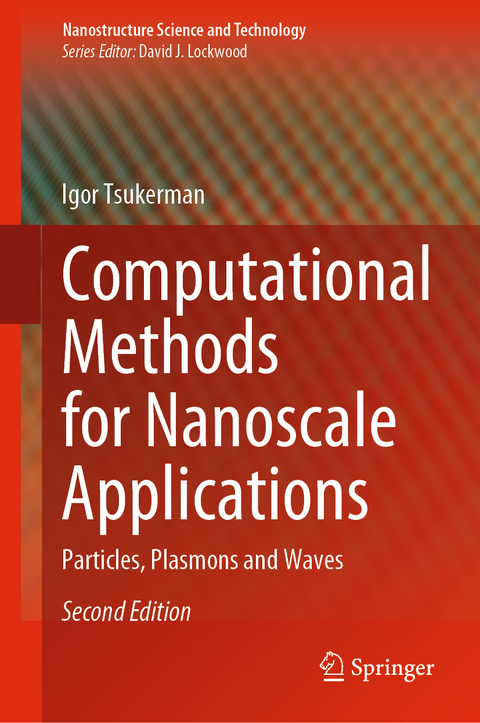
Computational Methods for Nanoscale Applications
Springer International Publishing (Verlag)
9783030438920 (ISBN)
This second edition of a well-received book presents new perspectives on modern nanoscale problems, where fundamental science meets technology and computer modeling. Along with traditional computational techniques such as finite-difference schemes, finite element analysis and Ewald summation, the book describes a new finite-difference calculus of Flexible Local Approximation MEthods (FLAME), which qualitatively improves the numerical accuracy in a variety of problems. Application areas in the book include long-range particle interactions in homogeneous and heterogeneous media, electrostatics of colloidal systems, wave propagation in photonic crystals, photonic band structure, plasmonic field enhancement, metamaterials, backward waves and negative refraction, cloaking, focusing beyond the diffraction limit, and transformation optics. The second edition incorporates new chapters on metamaterials and on the finite difference time domain method (FDTD), an exposition of absorbing boundary conditions, and Miscellany - a collection of paradoxical or controversial subjects related to the main topics of this book. A vast volume of material has been updated, revised or rewritten.
Computational Methods for Nanoscale Applications, Second Edition, is accessible to specialists and graduate students in diverse areas of nanoscale science and technology, including physics, engineering, chemistry, and applied mathematics. In addition, several advanced topics will be of interest to the expert reader.
Igor Tsukerman is Professor of Electrical and Computer Engineering at the University of Akron, Ohio, where he has been a faculty member since 1995. His research is focused on the simulation of nanoscale systems, applied electromagnetics and photonics, plasmonics, computational methods, and nonlocal homogenization of materials. He teaches a variety of undergraduate and graduate courses (Signals & Systems, Circuits, Electromagnetic Fields, Digital Signal Processing, Random Signal Analysis, Simulation of Nanoscale Systems, and others). Tsukerman has approximately 150 refereed publications, has authored a monograph (Computational Methods for Nanoscale Applications: Particles, Plasmons and Waves, Springer 2008) and co-edited a book (Plasmonics and Plasmonic Metamaterials: Analysis and Applications, World Scientific, 2011). Before coming to the University of Akron, Tsukerman worked at the Department of Electrical & Computer Engineering, the University of Toronto (1990-1995). A joint project with GE Canada involved electromagnetic field analysis and noise reduction in large electric motors. Tsukerman's academic degrees are from St. Petersburg Polytechnic in Russia: a combined B.Sc. / M.Sc. degree (with honors) in Control Systems (1982) and a Ph.D. in Electrical Engineering (1988).
Introduction.- Finite-Difference Schemes.- The Finite Element Method.- Flexible Local Approximation MEthods (FLAME).- Long-Range Interactions in Free Space.- Long-Range Interactions in Heterogeneous Systems.- The Finite Difference Time Domain Method.- Nano-Photonics: Periodic Media and Band Structure Computation.- Nano-Photonics: Plasmonics.- Metamaterials and Homogenization.- Conclusion: "Plenty of Room at the Bottom" for Computational Methods.
"The book is primarily addressed to computational material scientists. The level of intended readers ranges from graduate students, with a solid background in electromagnetism, to experienced researchers ... . The style of presentation is lucid and not overloaded with mathematical rigor, which is definitely an advantage, given the intended audience. ... The typesetting and editing have been done with care." (Radoslaw Szmytkowski, zbMATH 1494.78003, 2022)
“The book is primarily addressed to computational material scientists. The level of intended readers ranges from graduate students, with a solid background in electromagnetism, to experienced researchers … . The style of presentation is lucid and not overloaded with mathematical rigor, which is definitely an advantage, given the intended audience. … The typesetting and editing have been done with care.” (Radosław Szmytkowski, zbMATH 1494.78003, 2022)
| Erscheinungsdatum | 23.08.2020 |
|---|---|
| Reihe/Serie | Nanostructure Science and Technology |
| Zusatzinfo | XXVII, 707 p. 216 illus., 139 illus. in color. |
| Verlagsort | Cham |
| Sprache | englisch |
| Maße | 155 x 235 mm |
| Gewicht | 1262 g |
| Themenwelt | Naturwissenschaften ► Physik / Astronomie ► Atom- / Kern- / Molekularphysik |
| Naturwissenschaften ► Physik / Astronomie ► Festkörperphysik | |
| Technik | |
| Schlagworte | Absorbing boundary conditions • computer modeling nanoscale • discontinuous Galerkin methods • Ewald summation • Finite-Difference Schemes • finite difference time domain method • Flexible Local Approximation MEthods (FLAME) • long-range particle interactions • Nano-Photonics Computational Applications |
| ISBN-13 | 9783030438920 / 9783030438920 |
| Zustand | Neuware |
| Informationen gemäß Produktsicherheitsverordnung (GPSR) | |
| Haben Sie eine Frage zum Produkt? |
aus dem Bereich


